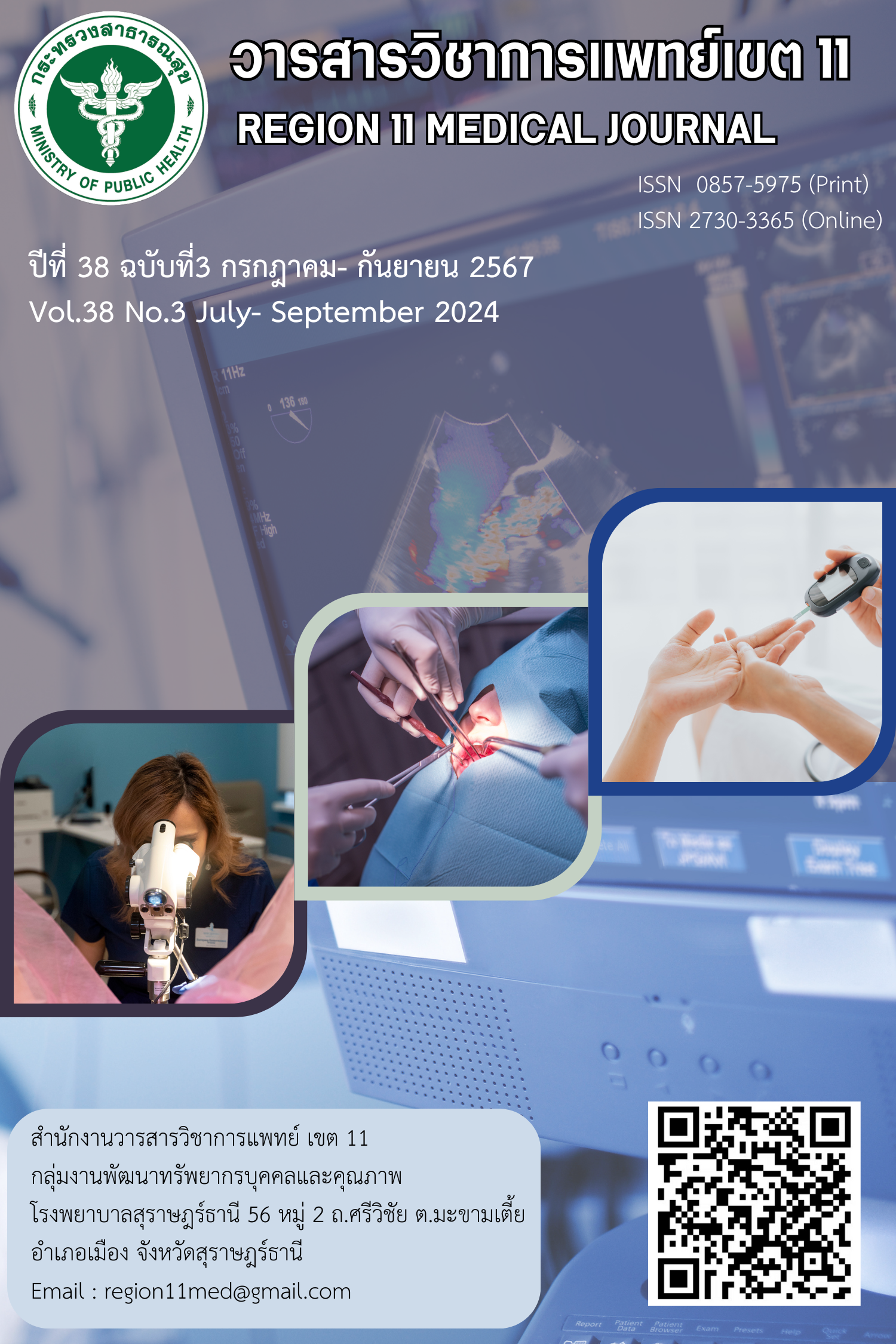The Effectiveness of Nursing Care for Hypothermia Program in Severe Injury Patients in Emergency Department
Keywords:
Hypothermia, Nursing care for hypothermia, Severe injuryAbstract
Background: Accidental injury is a life-threatening health problem in global and Thailand. Hypothermia is a factor that increases the death rate in severe injured patients. Therefore, the researcher was interested in studying the results of the hypothermia nursing program in severe injury patients.
Objectives: Compare the average body temperature of severe injury patients between the control group and the experimental group.
Method: This research is quasi-experimental research (two-group pretest-posttest design). The sample groups are ISS score ≥ 16, aged 18-60 years, body temperature ≤ 36 C, total 52 severe injury patients, a control group of 26 samples received usual nursing care and experimental group of 26 samples received nursing care for hypothermia program. Two instruments were used for data collection. Content validity of the instruments were examined by 3 experts. The data were analyzed using descriptive statistics, independent t-test and repeated measures ANOVA.
Results: The mean body temperature of the experimental group after receiving the program ( = 36.72, S.D. = 0.31) was higher than that of the control group with a significantly (p <.05). The difference in mean body temperature after using the program was significantly (p < .05) during time 2, 3 and 4.
Conclusion: Nursing care for hypothermia program in severe injury patients in emergency department (ED) as a guideline for increases body temperature.
References
World Health Organization. Global status report on road safety 2023 [internet]. Available from: https://iris.who.int/bitstream/handle/10665
/375016/9789240086517-eng.pdf?sequence=1
สถาบันการแพทย์ฉุกเฉิน. สถานการณ์และแนวโน้มสุขภาพและการแพทย์ฉุกเฉิน (ระดับโลกและประเทศไทย). [อินเตอร์เน็ต]. 2562 [เข้าถึงเมื่อ 18 มีนาคม 2566]. เข้าถึงได้จาก https://www.niems.go.th/1/UploadAttachFile/2021/EBook/414441_20211229135756.pdf.
Rosli D, Schnuriger B, Candinas D, Haltmeier T. The impact of accidental hypothermia on mortality in trauma patients overall and patients with traumatic brain injury specifically: a systematic review and meta-analysis. World J Surg 2020;44:4106-17.
Hassandoost R, Dinmohammadi M, Roohani M. Accidental hypothermia and related risk factors among trauma patients admitted to the emergency department. PCNM 2021;11(1): 63-70. doi: 10.52547/pcnm.11.1.63.
Jalali A, Norouzadeh R, Dinmohammadi M. Accidental hypothermia and related risk factors among trauma patients in prehospital setting. Disaster Emerg Med J 2023;8(1):21-6.
Kaide, C., Reichert, E., Whitson, B., Mast, D., Stahl, D. Management of accidental hypothermia. The Ohio State University; 2018.
Meiman J, Anderson H, Tomasallo C. Hypothermia-related deaths–Wisconsin, 2014, and United States, 2003-2013. MMWR 2015;64(6):141-143.
American College of Surgeons. Advanced trauma life support 10th edition. United states of America; 2018.
Dow J, Giesbrecht GG, Danzl DF, Brugger H, Sagalyn EB, Walpoth B, et al. Wilderness medical society clinical practice guidelines for the out-of-hospital evaluation and treatment of accidental hypothermia: 2019 update. Wilderness Environ Med 2019;30(4):47-69.
Lapostolle F, Sebbah JL, Couvreur J, Koch FX, Savary D, Tazarourte K, et al. Risk factors for onset of hypothermia in trauma victims: the hypotraum study. Crit Care 2012;16(142):1-7. doi: 10.1186/cc11449.
Paal P, Pasquier M, Darocha T, Lechner R, Kosinski S, Wallner B, et al. Accidental hypothermia: 2021 Update. IJERPH 2020;19(501):1-25.
สมจิตต์ เหล่าพิรุฬห์. ผลของการให้โปรแกรมอบอุ่นร่างกายต่ออุณหภูมิแกนและอาการหนาวสั่นในสตรีตั้งครรภ์ที่มารับการผ่าตัดคลอดบุตรทางหน้าท้องที่ได้รับการระงับความรู้สึกตัวด้วยวิธีฉีดยาชาเข้าช่องน้ำไขสันหลัง โรงพยาบาลกุมภวาปี. วารสารการพยาบาลสุขภาพและการศึกษา 2564;4(1):2-11.
ภารดี ชาวนรินทร์, ทิพพาพรรณ เดียวประเสริฐ, ปุณณิภัสส์ อริยะปรานต์, สมฤดี กีรตวนิชเสถียร.การป้องกันภาวะอุณหภูมิกายต่ำในทารกแรกเกิด. วารสารพยาบาล 2564;70(4):52-9.
ธันยมัย ศรีหมาด. การพัฒนาและประเมินผลการใช้แนวปฏิบัติพยาบาลในการจัดการภาวะอุณหภูมิกายต่ำในผู้ป่วยอุบัติเหตุรุนแรง ณ ห้องฉุกเฉิน โรงพยาบาลสงขลานครินทร์. (วิทยานิพนธ์ปริญญาพยาบาลศาสตรมหาบัณฑิต). บัณฑิตวิทยาลัย: มหาวิทยาลัยสงขลานครินทร์; 2553.15. สถิติห้องฉุกเฉิน โรงพยาบาลหาดใหญ่. สถิติผู้ป่วยบาดเจ็บปี พ.ศ. 2563-2565. สงขลา: โรงพยาบาลหาดใหญ่; 2565.
Cohen J. Statistical power analysis for the behavioral sciences. 2nd Newyork: Routledge Academic; 1988.
รัตนา เพิ่มเพ็ชร์, นงนาจ แก้วใจ, อารีย์พรรณ โสภณสฤษฎ์สุข. ผลของการใช้สารน้ำอุ่นล้างในช่องท้องต่อภาวะอุณหภูมิส่วนกลางของร่างกายขณะผู้ป่วยได้รับการผ่าตัดผ่านกล้องทางนรีเวช. วารสารพยาบาลทหารบก 2559;17(2):97-106.
Polit DF, Beck CT. Nursing research: generating and assessing evidence for nursing practice. 10th ed. Philadelphia (PA): Wolters Kluwer; 2017.
AvellanasChavala ML, Gallardo MA, Martinez IS, Bayego ES. Management of accidental hypothermia: A narrative review. Med Intensiva 2019;43(9):56-68.
Lundgren P, Henriksson O, Naredi P, Bjornstig U. The effect of active warming in pre-hospital trauma care during road and air ambulance transportation - a clinical randomized trial. SJTREM 2011;19(59):1-7.
Perlman R, Callum J, Laflamme C, Tien H, Nascimento B, Beckett A, et al. A recommended early goal-directed management guideline for the prevention of hypothermia-related transfusion, morbidity, and mortality in severely injured trauma patients. Crit Care 2016;20(107):1-11. doi: 10.1186/s13054-016-1271-z.
McLellan H, Rijnhout T, Peterson LM, Stuhlmiller D, Edwards J, Jarrouj A, et al. Prehospital active and passive warming in trauma patients. Air Med J 2023;42(4):252-8. DOI: 10.1016/j.amj.2023.03.005
Downloads
Published
How to Cite
Issue
Section
License

This work is licensed under a Creative Commons Attribution-NonCommercial-NoDerivatives 4.0 International License.





